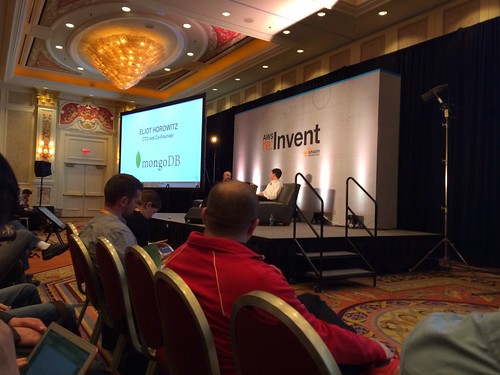One of the interesting sessions at ReInvent was a fireside chat with Werner Vogels., where CEO’s or CTO’s of different companies/startups who use AWS talked about their applications/platforms and what they liked and wanted form AWS. It was a 3 part series with different folks, and I was able to attend the 1st one, but I’m guessing videos are available for the others online. Interesting session, giving the audience a window into the way C level people think about problems and solutions…
First up, the CTO of mongodb…

Lots of people use mongo to store things like user profiles etc for their applications. Mongo performance has gotten a lot better because of ssd’s
Recently funded 150 million, and wanting to build out a lot of tools to be able to administer mongo better.
Apparently being a mongodb dba is a really high paying job these days!
User roles may be available in mongo next year to add more security.
Werner and Eliot want to work together to bring a hosted version of mongo like RDS.
Next up twilio’s Jeff Lawson
Jeff is ex amazon.

Software people want building blocks and not some crazy monolithic thing to solve a problem. Telecom had this issue, and that is why I started Twilio.
Everyone is agile! We don’t have answers up front, but we figure out these answers as we go.
Started with voice, then moved to SMS followed by a global presence. Most customers of ours wanted something that didn’t want boundaries and just wanted an API to communicate with their customers.
Werner: It’s hard to run an API business. Tell us more…
Lawson: It is really hard. Apis are kinda like webapps when it comes to scaling. REST helps a lot from this perspective. Multi tenancy issues gets amplified when you have an API business.
Twilio apparently deploys 20 times a day. Aws really helps with deployment because you can bring brand new environments that look exactly like prod and then tear it down when things aren’t needed.
When it comes to api’s, we write the documentation first and show our customers first before actually implementing the API. Then iterate iterate iterate on the development.
Jeff asks: Make it easier to make vpc up and running.
Next up: Valentino with adroll (realtime bidding)

There’s a data collection pipe which gets like 20 tb of data everyday.
Latency is king: Typically latency is like 50ms and 100ms. This is still a lot for us. I wish we had more transparency when it comes to latency inside aws and otherwise…
Why dynamo db? Didn’t find something simple at the time, and it was nice to be able to scale something without having to worry about it. We had 0 ops people at the time to work on scaling at the time.
Read write rates: 80k reads per second (not consistent), 40k writes per second.
Why erlang? You’re a python god.
I started working on Python with the twisted framework. But I realized that Python didn’t fit our use case well; the twisted system worked just as well but it would be complicated to manage it and needed a bit of hacks..
Today it would be hard to pick between erlang and go….













